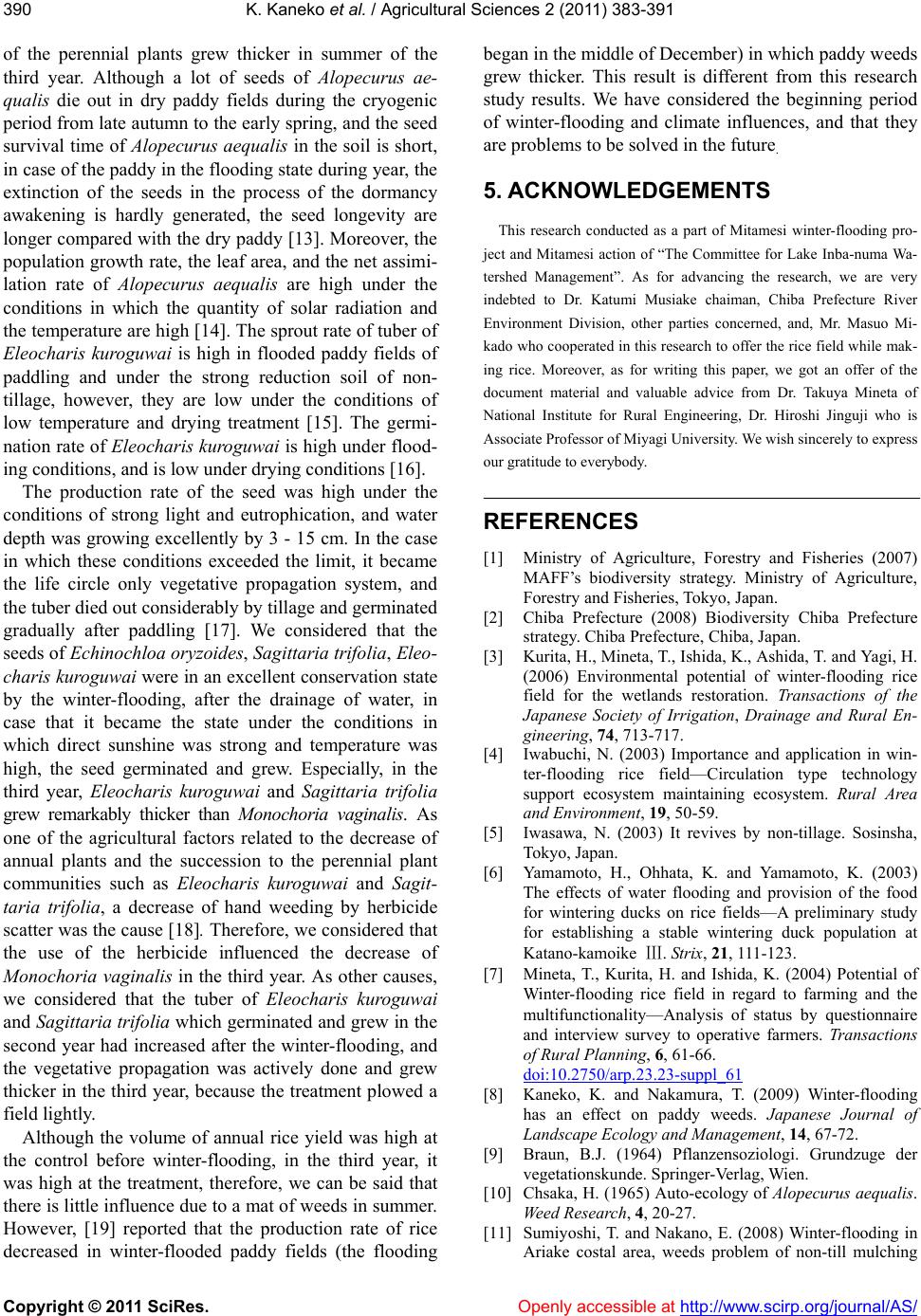
K. Kaneko et al. / Agricultural Sciences 2 (2011) 383-391
Copyright © 2011 SciRes. Openly accessible at http://www.scirp.org/journal/AS/
390
of the perennial plants grew thicker in summer of the
third year. Although a lot of seeds of Alopecurus ae-
qualis die out in dry paddy fields during the cryogenic
period from late autumn to the early spring, and the seed
survival time of Alopecurus aequalis in the soil is short,
in case of the paddy in the flooding state during year, the
extinction of the seeds in the process of the dormancy
awakening is hardly generated, the seed longevity are
longer compared with the dry paddy [13]. Moreover, the
population growth rate, the leaf area, and the net assimi-
lation rate of Alopecurus aequalis are high under the
conditions in which the quantity of solar radiation and
the temperature are high [14]. The sprout rate of tuber of
Eleocharis kuroguwai is high in flooded paddy fields of
paddling and under the strong reduction soil of non-
tillage, however, they are low under the conditions of
low temperature and drying treatment [15]. The germi-
nation rate of Eleocharis kuroguwai is high under flood-
ing condition s , and is low under drying conditions [16].
The production rate of the seed was high under the
conditions of strong light and eutrophication, and water
depth was growing excellently by 3 - 15 cm. In the case
in which these conditions exceeded the limit, it became
the life circle only vegetative propagation system, and
the tuber died out considerably by tillage an d g erminated
gradually after paddling [17]. We considered that the
seeds of Echinochloa oryzoides, Sagittaria trifolia, Eleo-
charis kuroguwai were in an excellent conservation state
by the winter-flooding, after the drainage of water, in
case that it became the state under the conditions in
which direct sunshine was strong and temperature was
high, the seed germinated and grew. Especially, in the
third year, Eleocharis kuroguwai and Sagittaria trifolia
grew remarkably thicker than Monochoria vaginalis. As
one of the agricultural factors related to the decrease of
annual plants and the succession to the perennial plant
communities such as Eleocharis kuroguwai and Sagit-
taria trifolia, a decrease of hand weeding by herbicide
scatter was the cause [18]. Therefore, we considered that
the use of the herbicide influenced the decrease of
Monochoria vaginalis in the third year. As other causes,
we considered that the tuber of Eleocharis kuroguwai
and Sagittaria trifo lia which germinated and grew in the
second year had increased after the winter-flooding, and
the vegetative propagation was actively done and grew
thicker in the third year, because the treatment plowed a
field lightly.
Although the volume of annual rice yield was high at
the control before winter-flooding, in the third year, it
was high at the treatment, therefore, we can be said that
there is little influence due to a mat of weeds in summer.
However, [19] reported that the production rate of rice
decreased in winter-flooded paddy fields (the flooding
began in the midd le of December) in which p addy weeds
grew thicker. This result is different from this research
study results. We have considered the beginning period
of winter-flooding and climate influences, and that they
are problems to be solved in the future.
5. ACKNOWLEDGEMENTS
This research conducted as a part of Mitamesi winter-flooding pro-
ject and Mitamesi action of “The Committee for Lake Inba-numa Wa-
tershed Management”. As for advancing the research, we are very
indebted to Dr. Katumi Musiake chaiman, Chiba Prefecture River
Environment Division, other parties concerned, and, Mr. Masuo Mi-
kado who cooperated in this research to offer the rice field while mak-
ing rice. Moreover, as for writing this paper, we got an offer of the
document material and valuable advice from Dr. Takuya Mineta of
National Institute for Rural Engineering, Dr. Hiroshi Jinguji who is
Associate Professor of Miyagi University. We wish sincerely to express
our gratitude to everybody.
REFERENCES
[1] Ministry of Agriculture, Forestry and Fisheries (2007)
MAFF’s biodiversity strategy. Ministry of Agriculture,
Forestry and Fisher ie s, Tokyo, Japan.
[2] Chiba Prefecture (2008) Biodiversity Chiba Prefecture
strategy. Chiba Prefecture, Chiba, Japan.
[3] Kurita, H., Mineta, T., Ishida, K., Ashida, T. and Yagi, H.
(2006) Environmental potential of winter-flooding rice
field for the wetlands restoration. Transactions of the
Japanese Society of Irrigation, Drainage and Rural En-
gineering, 74, 713-717.
[4] Iwabuchi, N. (2003) Importance and application in win-
ter-flooding rice field—Circulation type technology
support ecosystem maintaining ecosystem. Rural Area
and Environment, 19, 50-59.
[5] Iwasawa, N. (2003) It revives by non-tillage. Sosinsha,
Tokyo, Japan.
[6] Yamamoto, H., Ohhata, K. and Yamamoto, K. (2003)
The effects of water flooding and provision of the food
for wintering ducks on rice fields—A preliminary study
for establishing a stable wintering duck population at
Katano-kamoike Ⅲ. Strix, 21, 111-123.
[7] Mineta, T., Kurita, H. and Ishida, K. (2004) Potential of
Winter-flooding rice field in regard to farming and the
multifunctionality—Analysis of status by questionnaire
and interview survey to operative farmers. Transactions
of Rural Planning, 6, 61-66.
doi:10.2750/arp.23.23-suppl_61
[8] Kaneko, K. and Nakamura, T. (2009) Winter-flooding
has an effect on paddy weeds. Japanese Journal of
Landscape Ecology and Management, 14, 67-72.
[9] Braun, B.J. (1964) Pflanzensoziologi. Grundzuge der
vegetationskunde. Springer-Verlag, Wien.
[10] Chsaka, H. (1965) Auto-ecology of Alopecurus aequalis.
Weed Research, 4, 20-27.
[11] Sumiyoshi, T. and Nakano, E. (2008) Winter-flooding in
Ariake costal area, weeds problem of non-till mulching